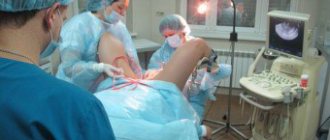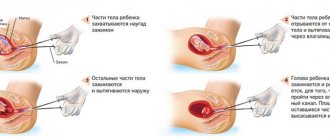After the procedure to remove the fetus, doctors give recommendations on how to help the body and recover after an abortion. There are two types of termination of pregnancy - abortion using medications (medication) and surgical abortion. No matter what type of expulsion procedure is performed, many women experience unpleasant side effects, including abdominal cramps, vaginal bleeding, breast pain, nausea and fatigue. The recovery period after an abortion lasts from 3 weeks to 6 months, but sometimes rehabilitation takes longer.
Recommendations after abortion:
- Drink at least 1.5 liters of water per day;
- If possible, stay in hospital for several days;
- Take vitamins, eat healthy foods, and get plenty of sleep;
- Take a course of vitamins and medications prescribed by your doctor;
- Do not engage in physical activity for at least 2 weeks;
- It is prohibited to lift weights exceeding 6 kg;
- Do not use vaginal accessories (tampons);
- Avoid sex for a period of 3-4 weeks;
- Do not take a bath and avoid going to the sauna for a month;
- Take oral contraceptives, which will most likely be prescribed by your doctor to normalize hormonal levels and avoid re-pregnancy.
There are cases when a woman is against taking oral hormonal contraceptives for personal or religious reasons. To avoid repeat pregnancy, it is necessary to use any contraception, since the body is capable of ovulation (conception) 2 weeks after an abortion. This is very important, since such a pregnancy can have great negative consequences.
The main thing is also to make sure that the abortion was performed correctly and the fetus was completely removed. There are situations when the abortion was incomplete, then it is necessary to resort to surgery and perform curettage to remove the remaining parts.
It is very important and necessary to be examined by a gynecologist 2 weeks after the abortion, who will check the condition of the uterus and make sure that there is no inflammation. The first thing to check is the uterus for infection. It is important to make sure that the cervix is completely closed - this may take 2 weeks or more after the abortion. When the cervix is open, there is a chance that bacteria can enter the uterine cavity and cause painful and dangerous infections. As soon as the cervix returns to its normal “closed” state, you can return to your usual lifestyle - swimming, taking a bath, and resuming sexual intercourse.
Symptoms of complications after abortion: early and late
Signs of complications after an abortion are different depending on whether we are talking about early or late symptoms.
As for the early signs, they will be as follows:
- Firstly, such complications arise during the surgical intervention itself or a short period after it. Most often this is bleeding;
- Another sign is pain in the lower abdomen, which is nagging in nature;
- Increased body temperature;
- Weakness and the appearance of bloody discharge mixed with pus from the woman’s genital tract.
Complications that can be observed in a woman in the early period are also inflammation of the peritoneum, which is called peritonitis, uterine perforation, puncture of the uterine wall, inflammation (adnexitis and endometritis).
A puncture of the uterine wall is the most dangerous of the complications, since it can lead to injury to other organs located nearby.
Complications and consequences of late-term abortion include hormonal disorders, infertility, miscarriage of a subsequent pregnancy, endometriosis, aggravation of acute processes in the pelvis, problems with the course of a subsequent pregnancy. Late complications of abortion tend to appear a year after the operation or even later. The causes of such consequences are considered to be the appearance of adhesions in the uterine cavity and changes at the hormonal level. Manifestations of late complications are also considered to be:
- Hyperplasia;
- Uterine fibroids;
- Endometritis.
Contraindications for the procedure
Since a mini-abortion is an invasive procedure and is considered a minor surgical operation, it has the same contraindications for its implementation as surgical termination of pregnancy:
- ectopic pregnancy;
- fever;
- infectious process of any localization (including “colds” on the lips);
- acute or exacerbation of chronic diseases of organs located in the pelvis;
- blood clotting disorder;
- Less than six months have passed since the previous termination of pregnancy.
In addition, vacuum mini-abortion is not performed and has its own specific contraindications:
- pregnancy exceeds 5 weeks (confirmed by ultrasound);
- malformations of the uterus;
- tumors of the uterus, due to which its cavity is deformed.
Treatment of post-abortion complications
The recovery period after an abortion (treatment of complications): is it possible or not that it will be delayed? It depends on how severe the complication resulting from this operation is. Statistics on consequences after abortions in Syktyvkar and other cities indicate that complications after abortions are indeed treatable. However, the success of such treatment will depend on many factors, for example, the severity of the complication itself, the woman’s current health condition and the qualifications of the doctor who will carry out the treatment.
In order to begin treatment, you need to be sure that there is no fertilized egg tissue left in the uterus. If there is a suspicion that the uterine cavity is not completely cleaned, it is necessary to treat with antibiotics and immediately remove any remaining fetal tissue.
How can a woman herself recognize that there is fetal tissue left in her uterus after an abortion? The following signs usually indicate this:
- Painful sensations in the back;
- Visible tissue in the cervical canal;
- Painful sensations in the pelvis or abdominal area;
- Intense bleeding, which can lead to a state of shock (sticky skin, increased sweating, increased pulse, dizziness, lightheadedness).
The doctor may detect remnants of fetal tissue when examining the pelvic area. The uterus will be soft on palpation and there will be obvious pain.
Course of pregnancy
Vacuum aspiration, which took place without complications, rarely affects the course of a new pregnancy. The restored uterine mucosa allows the embryo to attach securely and creates all the conditions for its full development. If pregnancy occurs too early (1-2 months after surgery), there is a high risk of miscarriage in the earliest stages.
Another problem awaiting expectant mothers is placental insufficiency. After an abortion, the placenta is not always able to form correctly and provide the baby with all the nutrients and oxygen. Hypoxia occurs, leading to various health problems in the newborn. It is possible that polyhydramnios may develop due to an intrauterine infection. In some women who have undergone a mini-abortion, the body's adaptation to bearing a child is disrupted. Preeclampsia develops - one of the most severe complications of pregnancy, threatening the condition of the expectant mother and her baby.
According to WHO, vacuum aspiration is considered one of the safest methods of medical abortion. Despite the risk of possible complications, most women tolerate this procedure safely. A mini-abortion without complications does not prevent pregnancy and the birth of a healthy child.
Complications after medical abortion
Many women tend to believe that medical abortion is gentle and safe for their body. But this is an absolute fallacy. Medical abortion can also negatively affect the female body. What negative consequences tend to occur after such interference in the normal functioning of the female body?
- An allergic reaction to the drug used to carry out the pharmacological abortion;
- Infection entering the body;
- Disturbances of normal hormonal levels;
- The appearance of severe bleeding;
- Incomplete abortion, that is, a situation where part of the embryo remains in the uterus.
When should a woman see a doctor urgently? This must be done after she notices the following signs after a medical abortion:
- Intense pain in the lower abdomen;
- Feverish state;
- Discharge that looks like large clots. The appearance of such discharge for two hours or more should be a reason to consult a doctor;
- Frequent heartbeat;
- Swelling of the abdomen;
- Vaginal bleeding, which in its duration is equal to fifteen days or more;
- Unpleasant odor coming from the discharge;
- Vomiting that does not stop for several hours;
- Painful sensations, redness in the genital area.
All of the above symptoms should be a reason for an emergency visit to the doctor.
Any type of termination of pregnancy is a serious intervention in our body, which entails the risk of certain consequences and complications. To prevent these conditions, regular examination by a gynecologist and specific treatment during the recovery period after an abortion are required.
Doctors' advice
Doctors advise you to reconsider your diet. Healthy food will help restore the body faster due to the supply of nutrients. It is advisable to include protein-rich foods in your menu.
Sexual rest for two weeks is an important requirement after expulsion. Intimate communication not only activates pain, but also increases the risk of bleeding.
Full hygiene of the genital organs using hypoallergenic cosmetics is also necessary. It is better to do all kinds of hygienic procedures in the shower. The use of a bath is unacceptable due to the risk of infection of the wound cavity.
Douching and the use of sanitary tampons are not recommended.
Traumatization of the walls and cervix
Perforation of the uterine wall is possible when performing manipulations with surgical instruments. During pregnancy, the walls of the uterus soften, thin out and become loose, which increases the possibility of damage.
Traumatic injury to the cervix occurs when the cervical canal is dilated with Hegar dilators. This subsequently leads to isthmicocervical insufficiency and recurrent miscarriage. These conditions are diagnosed by a doctor immediately during surgical manipulation. They require medical or surgical treatment. In case of a life-threatening condition, the uterus is removed with or without appendages.
Examination before manipulation
Before undergoing a mini-abortion, a woman must undergo the following examination:
- medical examination in a gynecological chair (clarification of probable signs of pregnancy: cyanosis and softening of the cervix, enlarged and softened uterus);
- taking smears from the vagina, cervical canal and urethra, determining the degree of vaginal cleanliness;
- pregnancy test and mandatory ultrasound with a vaginal probe to exclude ectopic pregnancy;
- if necessary, testing for sexually transmitted infections (chlamydia, ureaplasmosis and others);
- general blood and urine tests;
- blood for syphilis, hepatitis B and C, HIV infection.
In some clinics, the patient may be sent for a consultation with a therapist, blood donation for biochemistry, determination of blood clotting, group and Rh factor (this examination is not mandatory and is not approved by order of the Ministry of Health of the Russian Federation).
Bleeding
Hemorrhages can be caused by damage to blood vessels or pathological neoplasms. This is facilitated by impaired contractility of the uterus, which is a common complication of abortion. The cause of bleeding is also the presence of remnants of the placenta or fertilized egg.
Hematometra is a pathological condition in which the outflow of blood from the uterine cavity is disrupted. This complication can result from:
- Blockage of the cervical canal with part of the fertilized egg, placenta, blood clot, etc.
- Impaired contractile function of the myometrium
- Presence of connective tissue adhesions
Incomplete abortion is the partial removal of the fertilized egg and its membranes from the uterine cavity. In this case, bleeding begins, pain in the lower abdomen increases, and endometritis develops with the addition of infection. In this case, a repeat surgical abortion is indicated.
Infection
Intervention in the uterine cavity entails a risk of infection and the development of an inflammatory process (salpingitis, endometritis, parametritis). In particularly severe and advanced conditions, peritonitis and sepsis may develop. If you experience discomfort in the lower abdomen and pathological discharge, you should immediately consult a doctor.
Late complications after abortion
- Discharge from the genitals. Normally, they will be bloody for three to seven days. It is worth carefully monitoring their quantity, color and smell. Changes in these parameters indicate the development of complications.
- Inflammatory diseases may appear within 3-5 days.
- Pathological changes in the menstrual cycle.
- Hormonal imbalance.
- Psychological disorders.
- The risk of ectopic pregnancy, miscarriage and infertility increases.
The reasons for the development of infertility after an abortion are:
- Obstruction of the fallopian tubes as a manifestation of inflammatory diseases with the development of adhesions.
- A hormonal disorder leading to the formation of an anovulatory cycle or a lack of progesterone, which is responsible for the development and maintenance of pregnancy.
- Structural changes in the endometrium that prevent implantation of the fertilized egg.
Recovery period after abortion
Rehabilitation helps reduce all possible complications. The recovery period after an abortion varies depending on the type of abortion, as well as existing complications. The duration of the recovery period and effectiveness are influenced by age and general health, the number of births and abortions. The gynecologist selects individually for each person the scope of necessary procedures, studies and medications. It is mandatory for everyone to undergo a repeat ultrasound, vitamin therapy, a balanced diet, and consultation with a mammologist and endocrinologist. The recovery period after an abortion is an integral part of treatment after this procedure.











